This is an Envoy Wide Angle, an all metal box camera made by Photo Developments Ltd of Birmingham, England between 1951 and at least 1955. The Envoy Wide Angle shoots 2¼” x 3¼” images on both roll film and sheet film using a clever film compartment that can accommodate both types of film. The Envoy Wide Angle features a fixed focus 64mm f/6.5 wide angle lens made by Taylor Taylor Hobson Ltd., mounted to a variety of different British or German leaf shutters. The inclusion of such a wide lens on what is otherwise a simple box camera was an unusual pairing but proved to be a capable camera.
Film Type: 120 / 620 Roll Film (eight 2¼” x 3¼” exposures per roll), Sheet Film Adapter
Lens: 64mm f/6.5 Taylor Taylor Hobson Envoy Wide Angle coated 4-elements in 4-groups
Focus: Fixed, 3 meters to 18 meters @ f/11, 1.2 meters to Infinity @ f/22
Viewfinder: Flip Up Wire Frame Viewfinder w/ Parallax Correction
Shutter: Epsilon Leaf
Speeds: T, B, 1/25 – 1/125 seconds
Exposure Meter: None
Battery: None
Flash Mount: None
Other Features: None
Weight: 614 grams
Manual: https://www.photomemorabilia.co.uk/Ilford/Envoy_%20WideAngle/EnvoyWA_ocr.pdf
How these ratings work |
The Evoy Wide Angle has a rare combination of a high quality and very wide angle lens in a simple box camera form factor with fixed focus, a wire frame viewfinder, a limited selection of shutter speeds, and support for both roll and sheet film. This combination allows the camera to shoot images with speed and simplicity unheard of in the professional medium format world. With support for two types of film, the camera gives a level of flexibility that very few box cameras offer. The Envoy Wide Angle isn’t a common camera, but for those who have the chance to shoot one, the experience is fun and the results are remarkable. | ||||||
| Images | Handling | Features | Viewfinder | Feel & Beauty | History | Age | |
| 2 | 2 | 1 | 1 | 2 | 1 | 30% | |
| Bonus | +1 for unlikely combination of features, a 6×9 box camera with an excellent wide angle lens | ||||||
| Final Score | 12.7 | ||||||
History
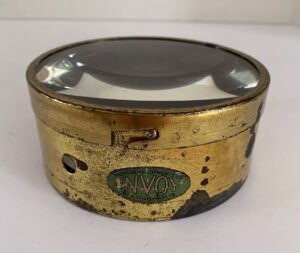
The Envoy Wide Angle was manufactured in the 1950s by a company called Photo Developments Ltd of Birmingham, England who, produced a wide variety of products for the photographic industry.
Photo Developments Ltd was founded by a chemist named Norman Mousely who after the war sought to fill a void in photographic products that could be imported into the country. A lack of German imports and that the Japanese camera industry didn’t yet have a foothold in Europe meant that if someone in England needed photographic goods, someone in England would need to make them.
It would take long before the production capabilities of Photo Developments Ltd caught the eye of the film company Ilford who marketed cameras and other non-film goods through its catalog and distribution network.
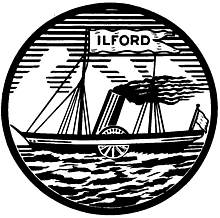 The origins of Ilford date back to a studio photographer named Alfred Hugh Harman who in the 1860s specialized in calotypes and other artificial light photography. In 1879 Harman would abandon his studio and started making photographic gelatine plates in the basement of his home. Initially doing all the work himself, Harman eventually hired staff to help him keep up with the demand from the quickly growing photographic industry.
The origins of Ilford date back to a studio photographer named Alfred Hugh Harman who in the 1860s specialized in calotypes and other artificial light photography. In 1879 Harman would abandon his studio and started making photographic gelatine plates in the basement of his home. Initially doing all the work himself, Harman eventually hired staff to help him keep up with the demand from the quickly growing photographic industry.
In 1883, Harman expanded to a larger location in East London where he could grow his business. The company operated under the name Britannia Works and in 1891 became a publicly traded company. The company would rename in 1898 as The Britannia Works Limited and once again in 1900 to Ilford Limited, a name taken from the the town the company was located in.
Over the next couple of decades, Ilford’s business continued to prosper. By the start of World War II, the British government declared Ilford to be essential to the war effort, providing necessary aerial reconnaissance supplies. It was classified by the war department as a Scientific Instrument Maker and munitions factory. This allowed the company to receive prioritization of raw materials and other types of economic protection.
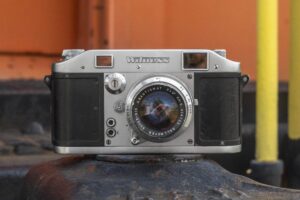
After the war, Ilford regained their reputation as the UK’s premiere photographic film and paper maker, but also transitioned into producing cameras. The company’s first, and most ambitious project began in 1947, which was to build a premium interchangeable lens 35mm rangefinder to compete with the German Leica and Contax rangefinders. Delays plagued the design and ultimate release of this camera and it wouldn’t hit the market until 1953 as the Ilford Witness at which point the photographic world had lost interest in a premium British rangefinder.
Like their US counterpart Kodak, Ilford was a film first company, and in order to generate more film sales, the company still had an interest in producing cameras. But like Kodak, Ilford realized that less expensive models that appealed to a larger audience would have the greatest impact on their film sales. As a result, Ilford would forge a partnership with another British company called Photo Developments Ltd to produce cameras to be sold under the Ilford name. A couple cameras like the Ilford Craftsman and Envoy came as a result of that partnership. These were simple and inexpensive cameras with Bakelite plastic bodies, simple single and dual element lenses, and single speed shutters that favored simplicity, making them appealing to the widest audience possible.
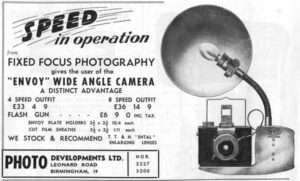
In 1950, Photo Developments Ltd would announce an all new camera that they were building for the professional market which would come with a Taylor Taylor Hobson wide angle lens. The camera would be called the Envoy Wide Angle and would be the first camera produced and sold under the Photo Developments Ltd name. Although sharing the Envoy name with the simple Ilford Envoy box camera which Photo Developments Ltd also made, the two cameras shared nothing in common.
The Envoy Wide Angle was an all metal camera that shot 2¼” x 3¼” images on 120 or 620 roll film or 2½” x 3½” images on sheet film. When the camera was sold new, it came in a kit with sheet film holders, but using a clever removable film compartment, the camera could also be loaded with roll film without ever having to change the back.
The Envoy Wide Angle first went on sale in 1951 and was not manufactured specifically for Ilford, but would soon be featured in Ilford catalogs, although without the Ilford name anywhere on the camera. Advertisements such as the one above from November 1951 do not feature Ilford’s name, suggesting that the camera could be purchased direct from the manufacturer, or perhaps through other retail outlets.
The Envoy Wide Angle always came with a 64mm f/6.5 Taylor Taylor Hobson Envoy Wide Angle lens, but could be configured with a variety of shutters made by companies such as Agilux, Epsilon, Prontor and Compur. The Compur shutter versions did not appear until at least 1952. The most common configurations are listed below with their retail prices in 1952.
- 4-speed Envoy (probably a rebranded Agilux) shutter 1/25 – 1/125 plus T and B, price £32.12s.4d
- 8-speed Epsilon shutter 1 – 1/250 plus T and B, price £36.2s.4d
- 9-speed Synchro-Compur shutter, fully synchronised, 1 – 1/500 plus B, price £43.17s.4d
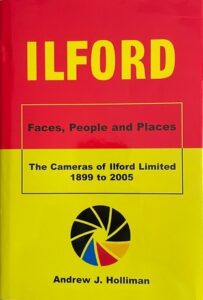
I was unable to find any contemporary articles or reviews of the camera, nor any information on how long it was produced or how many were made, but that it appeared in Ilford catalogs until at least 1955, at least suggests the camera sold modestly well. In the book, “Ilford: Faces, People and Places, the Cameras of Ilford Limited 1899 to 2005”, author Andrew J. Holliman states that the Envoy Wide Angle was very popular with Police and Fire Brigades, but was also widely used in architecture, and by real estate agents. Holliman further declares that as recently as 1983, the camera was still in use by various Police Departments.
I also suspect it might have appealed to semi-professional photographers used to shooting sheet film, but wanting the ability to make wide angle photos. The 4-element Taylor Taylor Hobson Envoy lens has a relatively slow f/6.5 maximum aperture and offers fixed focus, but when used in the right conditions, is capable of remarkable image quality. I suspect that the Envoy Wide Angle would have made for a popular “special purpose” backup camera for pros.
While the lack of Ilford’s name appearing on the camera suggests it might have been made for export out of the UK, I could find no evidence of this, so I am unsure of this model was ever sold in the US, nor would I be able to convert its selling price to anything resembling current day US dollars.
Today, cameras like the Envoy Wide Angle fall into a small niche of obscure cameras which few people talk about. Its combination of features, being a wide angle box camera with a good lens and flexible shutter don’t give it much competition, but also that its a British camera in an industry dominated by German and Japanese cameras doesn’t help its exposure either.
If however, this is a camera that you are interested in, it is a very cool example of a style of camera in which few were made. Although the Envoy Wide Angle very much is a simple box camera, it cannot be acquired as easily as most other simple box cameras. Even though there aren’t a lot of people talking about it, when ones do go up for sale, their price tags can be quite high. If you have a chance to try one out, I definitely recommend it!
My Thoughts
When is a box camera not a box camera? That is a question I don’t know many collectors have spent time thinking about but I guess it is worth discussing here.
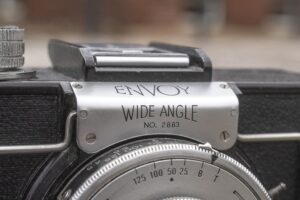
When most people think of a box camera, images of cardboard and wood Kodak Brownies or Ansco Cadet cameras with single speed shutters and meniscus lenses. These cameras were the “bread and butter” of the amateur camera industry for over half a century. Later box cameras switched from paper bodies to plastic or metal, some came in funky color, had larger viewfinders, and some even had unique appearances, but they were all still box cameras.
But what happens when you take a box camera, and substitute the single element lens with a wide angle 4-element lens, add a shutter with multiple speeds, and the ability to shoot both roll film or plate film. Is it still a box camera.
Such is the case with the Envoy Wide Angle. It is a camera in the shape of a box, so therefore it must be a box camera, but that this is a medium format camera that shoots 6cm x 9cm images using a multi-element 64mm lens makes it quite special. When shooting 6×9, a 64mm lens compares to a 28mm lens on 35mm film allowing it to capture far more visual information than a typical meniscus lens ever would, plus the much wider angle of view allows for increased depth of field, making focusing much easier.
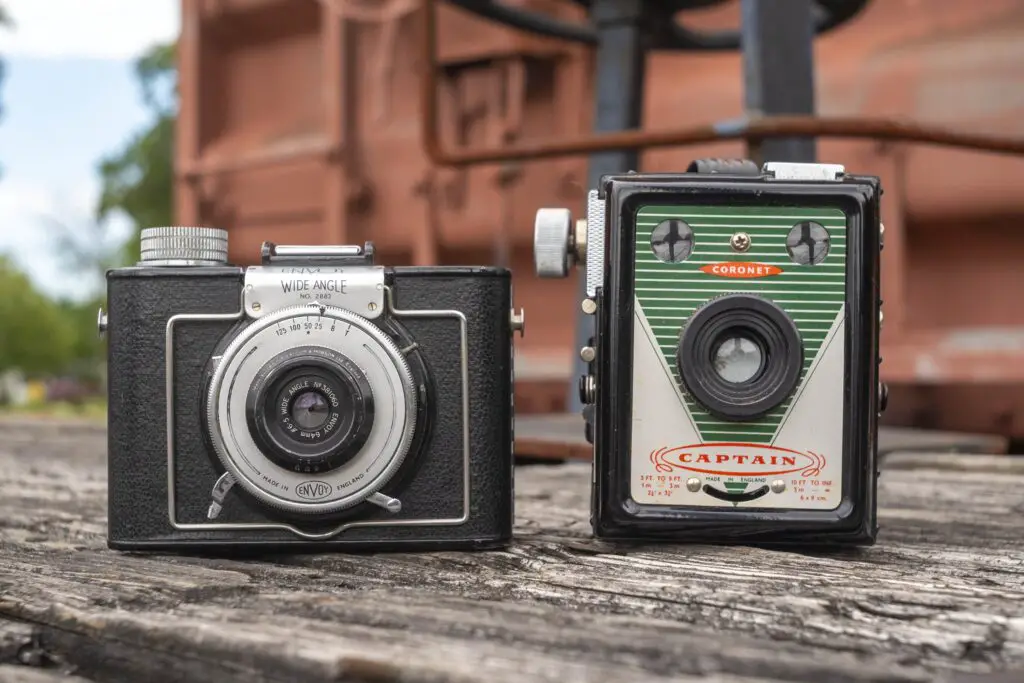
When I first came across this Envoy Wide Angle, I didn’t at first realize what it was or how special it could be, I dismissed it as another British curiosity. Upon further inspection, once I saw the lens and started to read about it, I definitely became more and more interested in using the camera. The most obvious reason is the prospect of wide angle 2¼” x 3¼” photos. There are only a few cameras in this format with lenses this wide and they’re all expensive. Off the top of my head, the Horseman Convertible and Fuji GSW690III come to mind when thinking about wide angle 2¼” x 3¼”. While each of those cameras are interesting and well worth considering, they are not only extremely expensive, but also quite a bit heavier and cumbersome to use. The Envoy Wide Angle is a hollow metal box with little in the way of controls, it is like a “Box Camera Plus”!
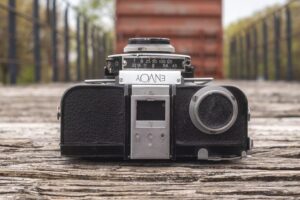
On the right side of the top plate is the large and very easy to grip film advance knob. Like most roll film cameras, the advance knob can only be turned in one direction and there is no return knob since you cannot rewind roll film. In the middle of the top plate is the rear portion of the viewfinder. The Envoy Wide Angle has a very simple wire frame finder that relies on this folding piece and a large wire frame that is folded down over the front lens and shutter.
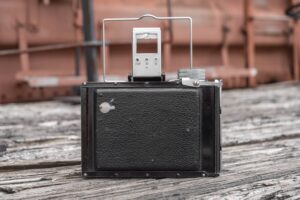
To use the viewfinder, you must fold both pieces up so that each are parallel to each. With the finder up, get your eye as close as you can to the rear opening until the edges of the wireframe begin to match the edge of the visible rectangle you are looking through. When your eye is in a position to where the wire frame just becomes visible through the rear opening, everything that you see inside of the wire frame is what will be captured on film.
The rear piece of the viewfinder has an interesting feature which allows for parallax correction by sliding an inner frame up until a green dot appears in one of three holes for 3 feet, 6 feet, and Infinity. This would be very useful when focusing the lens, except the lens on this Envoy Wide Angle is fixed focus. You cannot change the distance the lens is set to, so this feature is pretty useless on this camera. Perhaps other versions of this camera were planned with focusing lenses and they decided to include this feature on all of them.
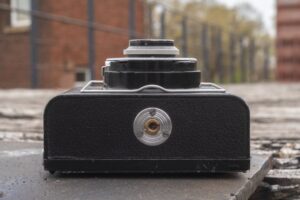
Flip the camera over and there’s not much to see on the bottom other than a centrally located tripod socket. It appears that the socket is supposed to be a 3/8″ socket, but this one has a brass adapter for 1/4″ tripods. Cameras from the 1940s and 50s commonly used 3/8″ tripod bushings as those were common in the era, but it makes sense for there to be an adapter in there if someone wanted to use a more modern tripod. In either case, that it is centrally located and made of metal means the camera would have excellent strength and balance while making long exposures.
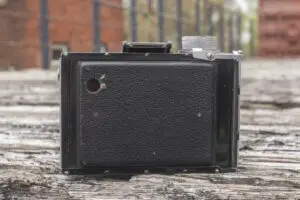
Around back is the film compartment door, which doubles as a sheet film holder for those who want to shoot individual 2½” x 3½” sheets through the camera. A spring loaded catch is in the upper right corner which if you press up while sliding the door to the right, the rear plate will come off. If you choose to shoot roll film in the camera, you’ll need to leave this door in place as not only does it prevent light from leaking into the film compartment, but it also has a red window with sliding door to read the exposure numbers on the backing paper.
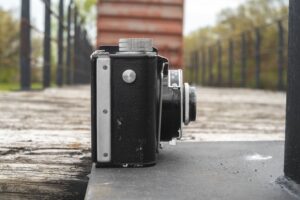
On the right side of the camera is a latch for releasing the hinge for the rear door. This release is only needed when shooting roll film through the camera. On both sides of the camera are circular posts which allow you to attach certain types of neck straps to the camera. This one did not come with one, so I am uncertain what style of strap you’d need.
As the only camera I’ve seen that natively supports both sheet film and roll film at the same time, the simplicity of how the Envoy Wide Angle was design is mighty impressive. Sheet film is attached to the rear door of the camera using a traditional holder, but roll film is mounted to a removable inner frame. It is possible to load in a roll of film, shoot the entire roll, and then without removing it from the camera, attach sheet film holders and keep shooting the camera, all without opening it. In the gallery below, I show three images of the film compartment in various configurations.
In the first image, the rear door is open with the roll film holder still in the camera. Film transports from left to right onto standard 120 or 620 spools. In this pic, I have an exposed roll of film on the right side, waiting to be removed and developed. A pressure plate is mounted to the inside of the rear door and must remain in place while roll film is being used in the camera.
It is impossible to load or unload film without removing the film holder, so the second image shows what this is like. Since this part of the camera is removable, it would be possible to find these cameras for sale with this piece missing, meaning it could only shoot sheet film, so if you’re in the market for an Envoy Wide Angle and you want to shoot roll film, be sure to check if this holder is here. With the holder out of the camera, film loads onto it the same as you’d expect on any roll film camera.
The third image shows the camera in sheet film configuration. With the rear plate removed, the roll film pressure plate is also removed. Three red velvet light strips flank the film gate for use with a standard 2½” x 3½” sheet film holder. In this third image, you can see the roll film holder is still in the camera. You can shoot sheet film with or without the roll film holder still in the camera, it makes no difference. If you were to remove the roll film holder, I suppose some kind of sheet to roll film adapter like a Rada or Rollfix adapter could be used, but I did not test this.
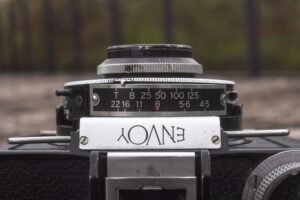
Looking down upon the shutter from the top of the camera we see a plate with shutter speeds and f/stops. This particular Envoy Wide Angle has the basic 4-speed Envoy branded shutter with speeds from 1/25 to 1/125 plus T and B. Shutter speeds are changed by rotating the ring around the outer edge of the shutter ring. Strangely, the f/stop scale shows a setting for f/5.6 and f/4.5 which the 64mm f/6.5 Taylor Taylor Hobson Envoy Wide Angle lens is not capable of. There is not even a pointer that points to any of these numbers, so the inclusion of the aperture scale in this location serves no purpose. Much like the redundant parallax correction feature of the viewfinder, I believe this is yet more evidence that more versions of this camera were planned, possibly with more advanced and faster lenses.
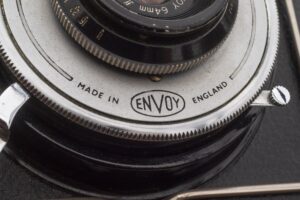
Changing the size of the lens diaphragm is done by rotating the black ring around the lens. Engraved into the ring near the bottom are four numbers indicating f/11 through f/32. Although this lens boasts a maximum f/6.5 aperture, nothing faster than f/11 is indicated, however you can rotate the ring to a position which approximates where f/6.5 might be. The Envoy Wide Angle manual suggests that f/11 is the largest working aperture and recommends f/16 or f/20 (which is not marked) give the best performance.
The Envoy Wide Angle is a fixed focus camera, which at first might seem like a con, but with the inclusion of the 64mm wide angle lens and working apertures of f/11 and smaller, the camera offers a huge depth of field. According to the manual, sharp pictures can be obtained at the following distances with these f/stops:
- f/11 – 10 feet to 60 feet
- f/16 – 6 feet to 400 feet
- f/22 – 4 feet to infinity
- f/32 – 30 inches to infinity
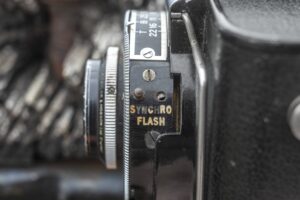
For photographers wishing to use the Envoy Wide Angle with a flash, a two prong sync port is available on the side of the shutter. On this example, one of the posts is missing, so it likely wouldn’t work. The Envoy Wide Angle manual suggests that GE No. 22 flashbulbs or Electronic flashes will work with the camera.
The Envoy Wide Angle is a very intriguing camera. It is likely the simplest wide angle option for 6×9 photography, but adding to the fact that you can choose both 120 and 620 roll film, or 2½” x 3½” sheet film, and shoot focus free shots in a 64mm 4-element lens in a metal bodied, flash synchronized camera is really exciting. It is clear to me that whoever designed this camera included a goal to make a camera just good enough to accomplish a goal, without over complicating it.
This is a simple camera but with very high end aspirations. I cannot think of another camera like it, but I know what you’re thinking, “Come on Mike, let’s see some pictures!” Since I’m not one to disappoint, keep reading…
My Results
While this review keeps going back and forth as to whether or not the Envoy Wide Angle should be considered a box camera, in the category of box camera like things, there’s very little to go wrong with this camera, so despite its age and the likelihood it hasn’t been used in a very long time, everything seemed to be in good working order the first time I took it out, so I ended up shooting two different rolls of film through the camera. The first was a fresh roll of Fomapan 100 and the second a fresh roll of Kodak Gold 200. I intended on shooting the camera using Sunny 16, so I thought both films would work well with the camera’s top 1/125 shutter speed.
I was pretty eager to see the results from the Envoy Wide Angle after developing the first two rolls. The combination of a wide angle lens on an extremely simple camera made for a fun shooting experience and I had thought that I captured some pretty cool shots.
After getting a look at the scans for the first time on my monitor, I was extremely pleased with what I saw. Having shot other wide angle medium format cameras like the Hasselblad SWC and Horseman Convertible, I found that the combination of a fun shooting experience combined with excellent results elevated the Envoy Wide Angle to be my favorite of the three.
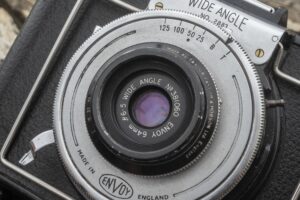
The images from the 4-element 64mm f/6.5 Taylor Taylor Hobson were quite good. I had read ahead of time that this lens was soft wide open so I stuck to apertures smaller than f/11, following the rules of Sunny 16 while shooting. Sharpness is excellent in the center but understandably softens near the edges, but never reaches that level of mushiness that you can sometimes get with lesser wide angle lenses. I was impressed at how little vignetting I saw in the corners or barrel distortion. While I didn’t shoot any intentional test photos to detect horizontal or vertical distortions, in the photos I took, nothing looked especially out of place. In addition, the lens did a good job with color film, rendering images with good clarity and vibrant colors, while maintaining an excellent level of sharpness while shooting black and white.
It is clear that the Envoy Wide Angle is a camera which is designed around its lens as there really isn’t much else to it. Much like the previously mentioned Hasselblad SWC or the Zeiss-Ikon Hologon Ultrawide, the camera body is mainly a light tight box whose purpose is to momentarily expose a strip of film to light, with as little as fuss as possible.
With no focus, only 4 shutter speeds, and a relatively small range of f/stops, there’s not much to shooting the Envoy Wide Angle, just point and shoot, but unlike many cameras whom the term “point and shoot” is applied, images from the Envoy Wide Angle are very special and therein lies the best thing about this camera.
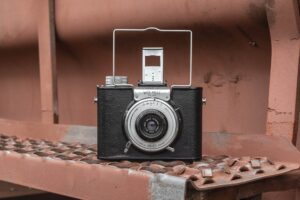
With such a simple operation, there’s little to complain about. I do not lament the lack of a focusing lens, rangefinder, or other advanced features because that would unnecessarily complicate the camera. I guess I would have liked a wider range of shutter speeds, but that could have been had with variants of this camera with a more advanced shutter. With the four that this one had, I had no issue with ASA 100 and 200 speed film while walking around in good lighting.
I think that having gone through my first test rolls of film, I’d like to revisit the Envoy Wide Angle and try some long exposures in building interiors, or maybe attempt some architecture photos, similar to how this camera might have been used when it was new. Knowing that the lens delivers excellent results in a fun and easy to use package, I can’t wait to see what other kinds of shots I can get the next time I load it up. If you have a chance to check one of these cameras out, I definitely recommend it. In the rare category of wide angle 6×9 cameras, this is a keeper!
Related Posts You Might Enjoy
External Links
http://camera-wiki.org/wiki/Envoy_Wide_Angle
https://www.photomemorabilia.co.uk/Ilford/Envoy_WA.html
https://forum.mflenses.com/envoy-wide-angle-6×9-camera-t47018.html
https://www.photo.net/forums/topic/331788-envoy-wide-angle-a-surprise-british-oddity/
https://www.35mmc.com/29/10/2019/5-frames-with-a-1950s-envoy-wide-angle-6×9-by-paul-elcock/
https://www.flickr.com/photos/43334883@N03/albums/72157626628856898/with/9632650148

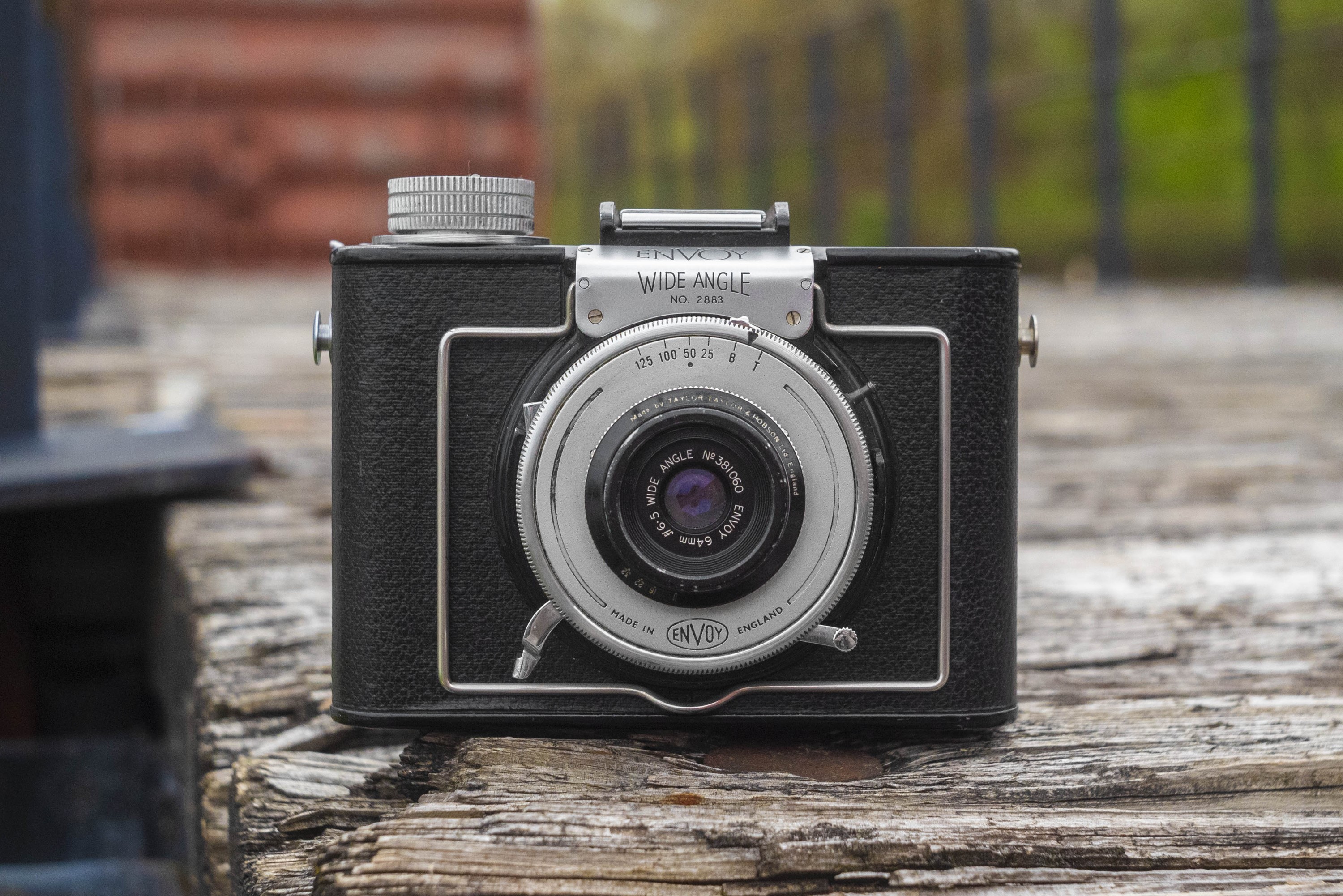
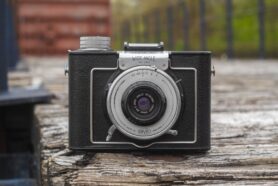
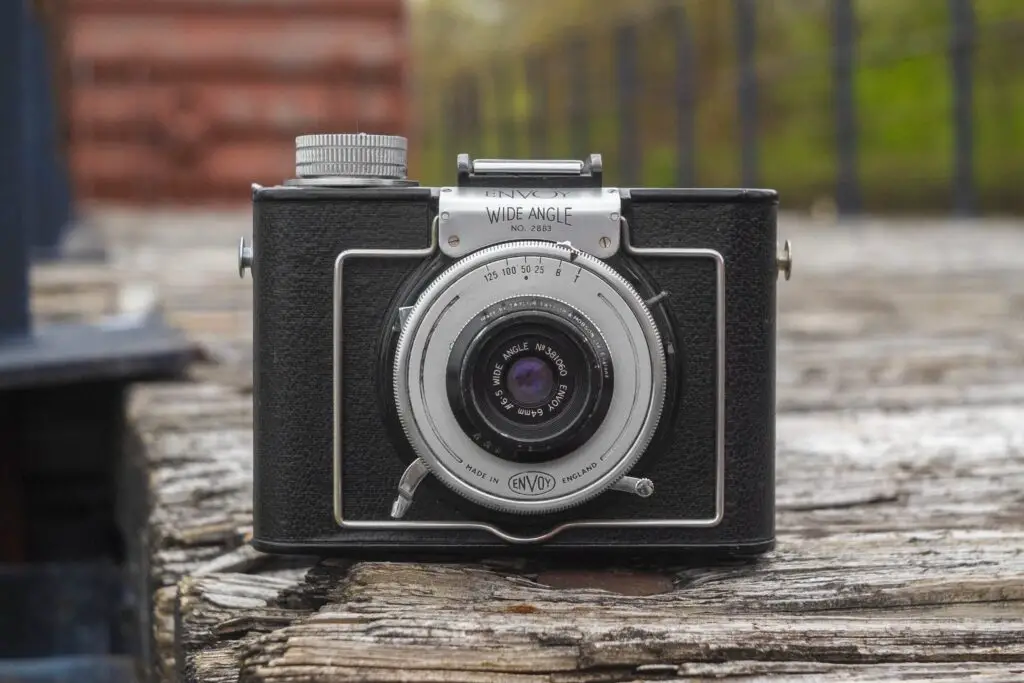
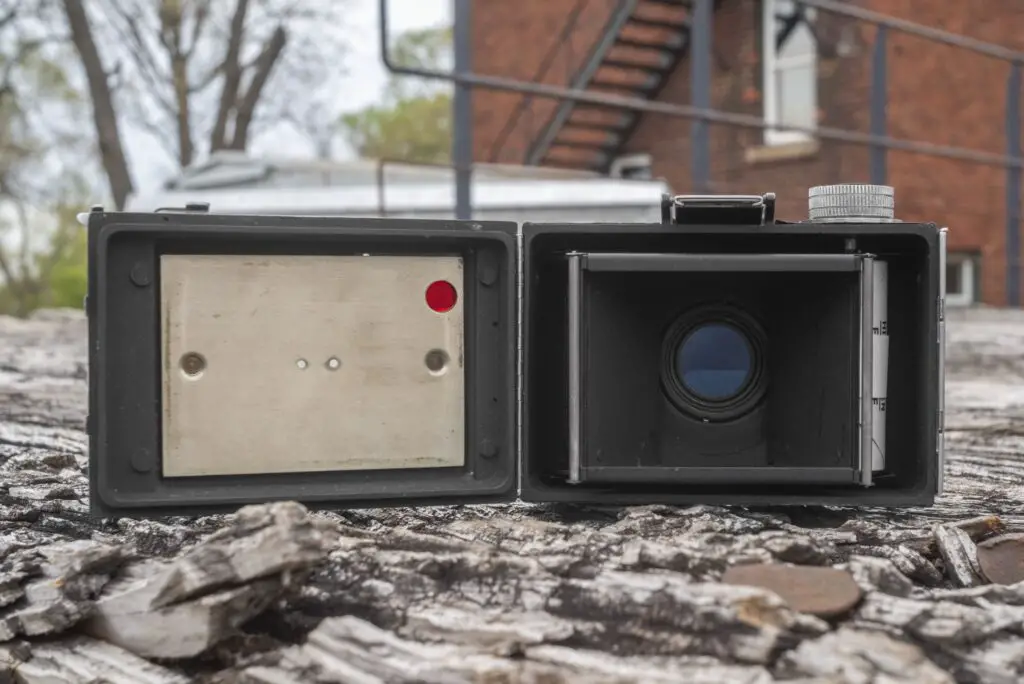
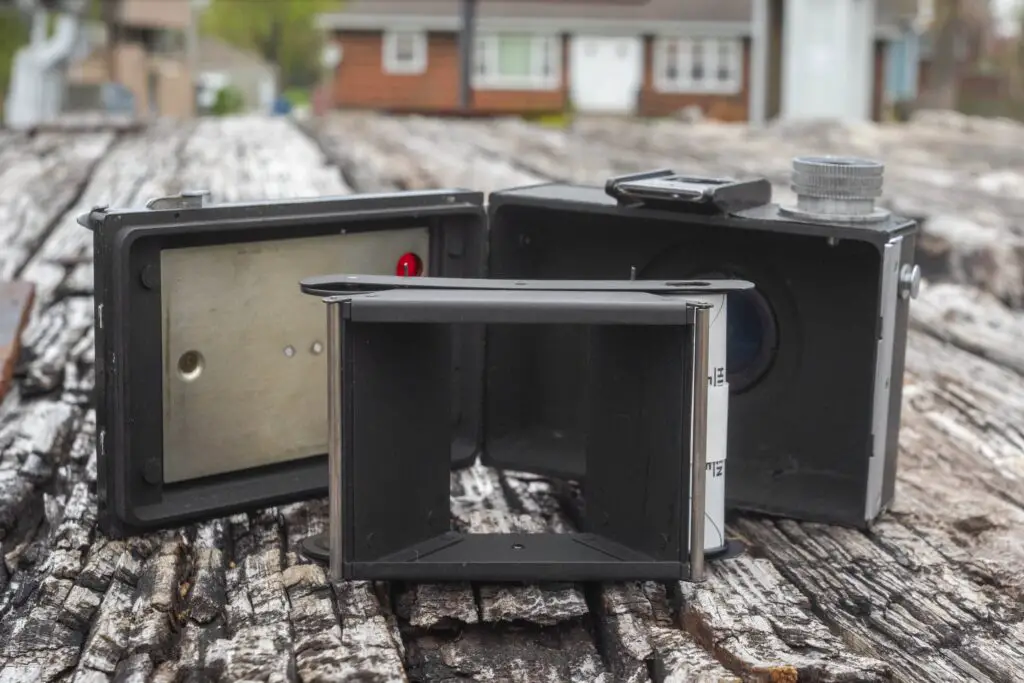
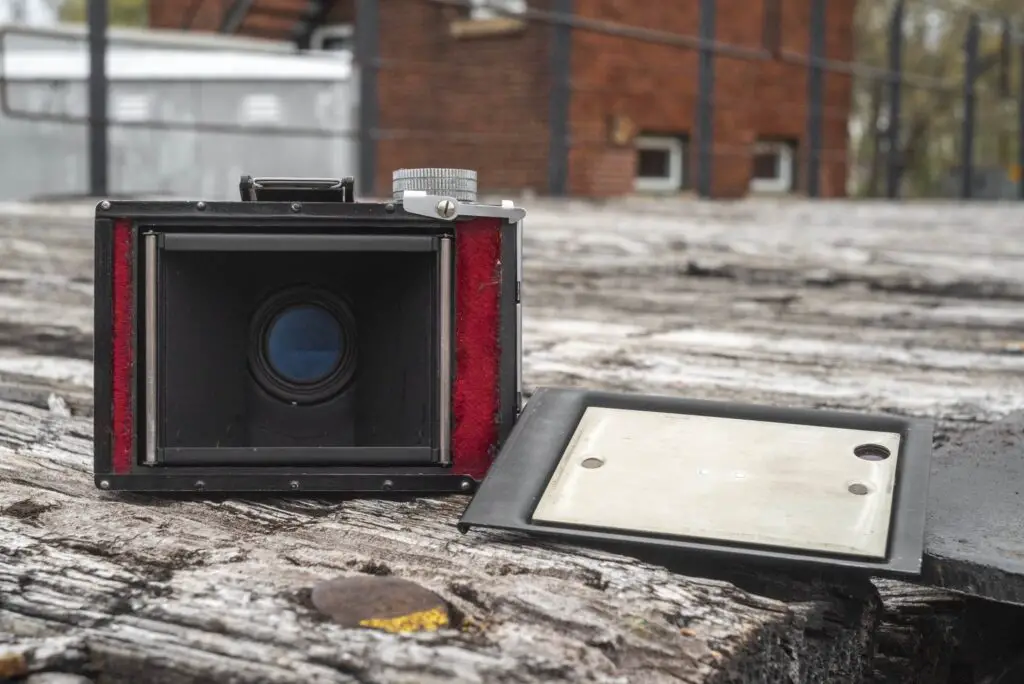














Strangely enough I bought the exact same model of this camera earlier this year. The results are astonishingly good for a simple four element lens of 28mm equivalent focal length, but then Taylor Taylor Hobson make superb lenses. I also have a British Microflex with a four element TTH Micronar lens and that lens is good enough to make Rollei users weep! My Envoy has a slight light leak which I have to find. It also uses a unique thread for the cable release socket, which is a shame, as this is a camera that begs to be used on a tripod. If anyone out there on the web knows where I could get an adaptor for the cable release I’d love to know. I am based in the UK. I believe that the photographer Bill Brandt used an Envoy to produce some of his extreme wide angle nudes. It is significant that most were taken on beaches where the light is very bright which will suit this camera. Great post, Mike!
I have one of these with a four speed shutter. I like to use it occasionally. One odd feature of mine is that the tripod socket is not light-tight; I use it with a tripod quick-release plate always attached and black electrical tape on the inside.